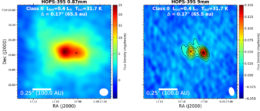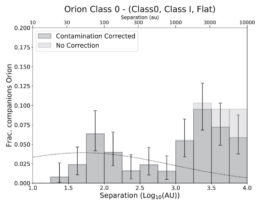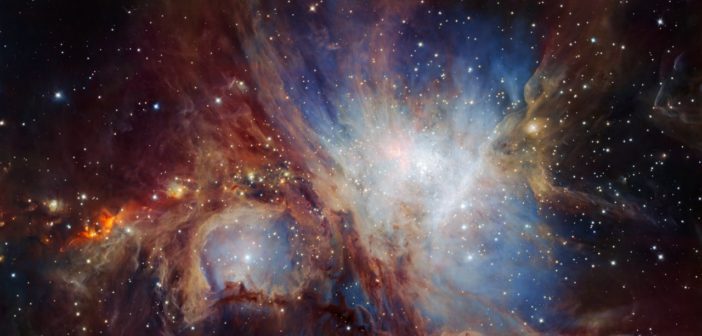
Visible-light image of the constellation Orion and the Orion nebula — located below the three stars of the “belt” — which is part of the Orion molecular cloud complex. [Wikipedia]
Star Formation in Our Backyard
When it comes to studying young stars, there’s no better place than the Orion molecular cloud complex: a network of active star-forming regions located just over a thousand light-years away. The Orion molecular clouds contain hundreds of protostars still siphoning gas from their nascent nebulae, making it a perfect arena for studying star formation.
The two leading theories for how stars form are disk fragmentation and turbulent fragmentation. The disk fragmentation theory suggests that a rotating disk of star-forming material can splinter into multiple stars. The turbulent fragmentation theory posits that small fluctuations within a dense clump of gas can ripple outward and induce a gas cloud to collapse. Key to distinguishing between these hypotheses are their length scales; disk fragmentation is thought to produce stars separated by roughly 100 au, while turbulent fragmentation likely generates more widely separated companions.
A First Look at New Stars
Studying star formation at small spatial scales is challenging, because short-wavelength light emitted by young stars is heavily obscured by gas and dust, and long-wavelength observations are inherently lower in resolution. Luckily, the advent of radio telescope arrays has increased the achievable resolution of radio images and allowed astronomers to probe smaller scales than ever before. A team led by John Tobin (National Radio Astronomy Observatory) has used the Atacama Large Millimeter/submillimeter Array (ALMA) and the Very Large Array (VLA) to investigate stellar companionship in the Orion molecular clouds at the earliest stages of star formation — and to explore what these findings mean for how stars form.

Example of observations from ALMA (left) and the VLA (right) of a young protostellar system. [Adapted from Tobin et al. 2022]
Competing Creation Scenarios

Separation distribution for multiple-star systems containing the youngest (Class 0) protostars. The dotted curve approximates the distribution for Sun-like stars in the field. [Adapted from Tobin et al. 2022]
The team concluded that more than half of all companions within 500 au likely formed through disk fragmentation, while those at larger separations likely only formed due to turbulent fragmentation. Hopefully, future studies of this rich protostar data set will reveal even more insights about star formation!
Citation
“The VLA/ALMA Nascent Disk And Multiplicity (VANDAM) Survey of Orion Protostars. V. A Characterization of Protostellar Multiplicity,” John J. Tobin et al 2022 ApJ 925 39. doi:10.3847/1538-4357/ac36d2
